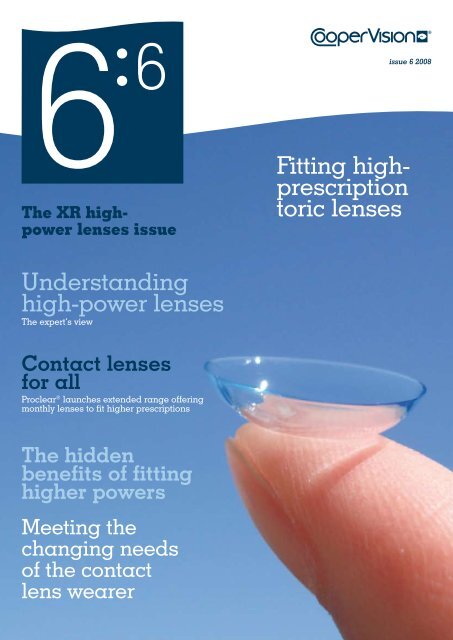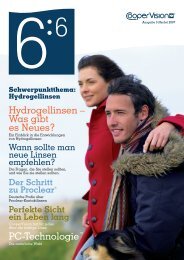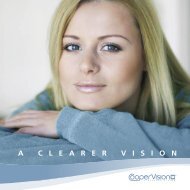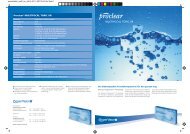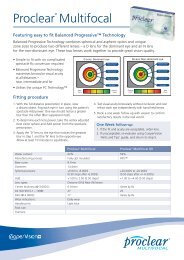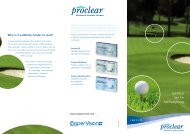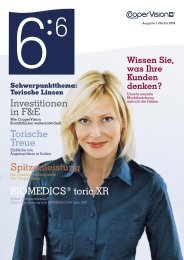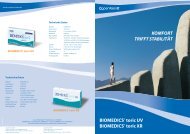English - final copy.pdf - Coopervision-training.com
English - final copy.pdf - Coopervision-training.com
English - final copy.pdf - Coopervision-training.com
Create successful ePaper yourself
Turn your PDF publications into a flip-book with our unique Google optimized e-Paper software.
issue 6 2008<br />
The XR highpower<br />
lenses issue<br />
Fitting highprescription<br />
toric lenses<br />
Understanding<br />
high-power lenses<br />
The expert’s view<br />
Contact lenses<br />
for all<br />
Proclear ® launches extended range offering<br />
monthly lenses to fit higher prescriptions<br />
The hidden<br />
benefits of fitting<br />
higher powers<br />
Meeting the<br />
changing needs<br />
of the contact<br />
lens wearer
Offer all day<br />
<strong>com</strong>fort to more<br />
of your patients<br />
Proclear ® contact lenses<br />
NOW AVAILABLE IN OVER 500,000<br />
DIFFERENT PARAMETER COMBINATIONS;<br />
• NEW Proclear ® Toric XR;<br />
monthly disposable toric lens with cylinder powers up to -5.75DC<br />
• NEW Proclear ® Multifocal XR;<br />
monthly disposable multifocal lens available in +/-20.00DS with Add powers up to +4.00D<br />
• NEW Proclear ® Multifocal Toric;<br />
monthly disposable toric lens with cylinder powers up to -5.75DC and Add powers up to +4.00D<br />
Specification<br />
Proclear ® Toric XR<br />
Water content: 59%<br />
Base curve:<br />
8.8mm<br />
Diameter:<br />
14.4mm<br />
Spherical powers: +6.00 to -8.00DS<br />
(0.50 steps after -6.50)<br />
Cylinder powers: -2.75 to -5.75DC (0.50 steps)<br />
Axis:<br />
5˚ to 180˚ (5˚ steps)<br />
Dk: 25<br />
Orientation mark: 1 marker at 6 o’clock<br />
Wear indications: Daily wear<br />
Modality:<br />
Monthly disposable<br />
Pack size:<br />
3 pack<br />
Trial lens:<br />
Available in all parameters<br />
Specification<br />
Water content: 59%<br />
Base curve:<br />
8.7mm<br />
Diameter:<br />
14.4mm<br />
Spherical powers:<br />
(for Add powers: +1.00<br />
to +2.50)<br />
Spherical powers:<br />
(for Add powers: +3.00<br />
to +4.00)<br />
Add powers:<br />
Lens type:<br />
Proclear ® Multifocal XR<br />
+4.25 to +20.00,<br />
-6.25 to -20.00<br />
(0.50 steps after +/- 6.50)<br />
+20.00 to -20.00<br />
(0.50 steps after +/-6.50)<br />
+1.00 to +4.00 (0.50 steps)<br />
Distance (D) and Near (N) lens<br />
Dk: 25<br />
Wear indications: Daily wear<br />
Modality:<br />
Monthly disposable<br />
Pack size:<br />
3 pack<br />
Trial lens:<br />
Available in all parameters<br />
Specification<br />
Proclear ® Multifocal Toric<br />
Water content: 59%<br />
Base curve:<br />
8.8mm<br />
Diameter:<br />
14.4mm<br />
Spherical powers: +20.00 to -20.00DS<br />
(0.50 steps after +/-6.50)<br />
Cylinder powers: -0.75 to -5.75DC (0.50 steps)<br />
Axis:<br />
5˚ to 180˚ (5˚ steps)<br />
Add powers: +1.00 to +4.00 (0.50 steps)<br />
Lens type:<br />
Distance (D) & Near (N) lens<br />
Dk: 25<br />
Orientation mark : Markings at 3 and 9 o’clock<br />
Wear indications: Daily wear<br />
Modality:<br />
Monthly disposable<br />
Pack size:<br />
3 pack<br />
Trial lens:<br />
Available in all parameters<br />
For further information contact your local Area Business Manager or to place an order:<br />
(t); 0870 9000 055 (f); 0870 9000 056 (w); order online at www.coopervision.<strong>com</strong>
Understanding<br />
high-power lenses<br />
– the expert’s view<br />
Chris Davison, Lathing Business Unit Manager at CooperVision, explains the<br />
varied methods used at CooperVision to manufacture its exhaustive range of<br />
high-power lenses.<br />
Before looking at the technical<br />
detail of how you manufacture highpower<br />
lenses, could you give a short<br />
explanation of what high-power<br />
lenses offer the practitioner<br />
CD Put simply, CooperVision is able to<br />
present the practitioner with more options<br />
for those needing higher powers than any<br />
other manufacturer. For the optician, this<br />
offers the advantage of a bigger product<br />
portfolio with the widest range of lenses and<br />
powers on the market as well as the greatest<br />
variety of modalities to suit the wearer.<br />
What methods are used in<br />
producing high-power lenses<br />
CD There are two basic methods. Firstly,<br />
the traditional fully lathed process<br />
whereby lenses are lathed on both the<br />
back and front surfaces. Secondly, utilising<br />
a hybrid process in which the base curve<br />
and often the edge are pre-moulded, and<br />
only the front surface is lathed.<br />
The traditional method of fully lathing<br />
is used on our stand-alone ranges, all<br />
of which are marketed as conventional<br />
lenses. The hybrid process is used on the<br />
range extensions and these products are<br />
sold as monthly lenses.<br />
After wet processing, in which the lenses<br />
are placed in their <strong>final</strong> packaging,<br />
they are autoclaved. Unusually for a<br />
manufacturing site we also label, carton,<br />
and despatch most of our product.<br />
What challenges do you face<br />
CD We are growing hugely in what we<br />
produce and what we offer; for example<br />
we currently make 13 different products<br />
with almost as many different processes!<br />
Because of this, we have initiated<br />
many engineering projects to find<br />
<strong>com</strong>mon manufacturing methods that<br />
will standardise the process as well as<br />
continue to improve quality and service.<br />
The other big challenge we face due<br />
to our tremendous growth is <strong>training</strong><br />
enough new staff in time to cope with<br />
the volume increases. Our headcount<br />
was 250+ by year-end and the volumes<br />
will be over two million custom lenses<br />
during our next fiscal year.<br />
Is there technology that is specific<br />
to producing high-power lenses<br />
CD We use state-of-the-art <strong>com</strong>puter<br />
controlled lathes designed to produce<br />
<strong>com</strong>plex geometries directly on a lens.<br />
Some of these lathes have ‘Oscillating<br />
Tool’ technology that allows us to directly<br />
cut toric zones or prismatic or dynamic<br />
stabilisation curves. We are also able to<br />
specify aspheric curves for products such<br />
as multifocal lenses. These lathes have<br />
air bearings and can repeatedly produce<br />
to a very high level of form accuracy and<br />
surface quality.<br />
How do the methods differ from<br />
normal-power lenses<br />
CD There are two main differences.<br />
At CooperVision, the majority of lenses<br />
are cast moulded and produced to stock<br />
in lots of many thousands. However,<br />
lathing produces lenses on a made-toorder<br />
basis. Each order may be a single<br />
lens each for right eye / left eye, or a<br />
three or six pack for each. Offering<br />
made-to-order lenses widens the<br />
available range of parameters beyond<br />
what is economically possible by the<br />
cast-moulding process. For those patients<br />
whose vision correction requirements<br />
are not serviced by the standard ranges,<br />
the practitioner can specify exactly the<br />
parameters required. These custom made<br />
lenses, in conjunction with our standard<br />
products, give the practitioner a wide<br />
range of options.<br />
How do the challenges differ<br />
from normal-power lenses<br />
CD In lathing, we can produce a lens<br />
of extreme power as easily as we can a<br />
plano. The hard work is done before the<br />
launch of a new product when the lathe<br />
is programmed and validated for the<br />
new design.<br />
The demand for a product dictates<br />
whether the lens is cast moulded or if it<br />
is lathed. When the demand is large, it<br />
makes economic sense to mould but as<br />
the volume demand drops away we can<br />
offer wider ranges of products to our<br />
customers by lathing outside of the bell<br />
curve, the higher prescriptions.<br />
Are there any differences to the<br />
lens wearer<br />
CD The lenses should be totally<br />
equivalent in terms of <strong>com</strong>fort, visual<br />
acuity and fit as those made by cast<br />
moulding or any other method, such as<br />
spin casting. The patient would not know<br />
what process has made his or her lenses<br />
because lenses may perform differently<br />
by material and design but not by<br />
manufacturing methods.
Meeting<br />
the changing<br />
needs of the<br />
contact lens<br />
wearer…<br />
Understanding how contact lenses are currently worn and what wearers would<br />
like to get from their lenses in future is a key factor in the development of new<br />
products and the market. By meeting wearers’ needs we can keep them in<br />
lenses for longer and therefore grow the market by reducing the current dropout<br />
rates. In the second year of our continuous research project, CooperVision<br />
questioned around 3,000 wearers in 13 European countries to gain a better<br />
understanding of their habits and desires.<br />
Contact lens wearers for life,<br />
not just a few years<br />
One of the first things we see is that<br />
wearers are staying in lenses for longer<br />
with 20% having worn lenses for over 10<br />
years and 5% for over 20 years. This<br />
increase in long-term wearing has been<br />
brought about by the advancement of<br />
disposable lenses. This increase also raises<br />
questions about the long-term impact of<br />
increased lens wear. Long-term wearing<br />
has created the need to ensure that the<br />
wearers are regularly upgraded with newer<br />
materials and lens designs that will have a<br />
better long-term benefit for the eye. It is<br />
also important to keep in mind that the<br />
incidence of presbyopia will be increasing<br />
within the wearer population and<br />
therefore the ability to successfully fit<br />
presbyopic lenses will be important in<br />
keeping these wearers in contact lenses.<br />
15%<br />
22%<br />
5%<br />
28%<br />
30%<br />
Fig.1: How long have you<br />
been wearing contact lenses<br />
Up to 2 years 2-5 years<br />
5-10 years 10-20 years<br />
Over 20 years<br />
The respect of the professional<br />
Yet again, CooperVision’s research has<br />
highlighted how much respect the wearer<br />
has for the practitioner. An amazing 37%<br />
of wearers state they leave the choice of<br />
brand purely to the optical professional.<br />
Additionally, another 27% attribute<br />
discussion with the practitioner as one of<br />
the main reasons for choosing their<br />
specific brand. So overall, 64% of wearers<br />
are heavily influenced in their choice of<br />
product by their practitioners. The research<br />
also highlighted that, when measured<br />
among wearers of CooperVision products,<br />
this figure increases to 72%. Even in the<br />
information-saturated modern world,<br />
contact lens wearers across Europe still<br />
look to the practitioner as the most<br />
important source for making their lens<br />
and brand selection.<br />
Upgrading to increase<br />
satisfaction<br />
One of the main advantages of market<br />
research is in discovering what wearers<br />
would like from their lenses to make the<br />
experience even more enjoyable. Currently,<br />
we found around 16% of wearers sleep<br />
overnight in their lenses with two thirds of<br />
these doing this for just a few days a<br />
week. However, when asked if they would<br />
like to sleep overnight in lenses around<br />
70% said “yes” with over half of these<br />
just wanting to sleep in their lenses a<br />
couple of times a week.<br />
Overall lens performance is high, yet<br />
wearers can still easily identify areas<br />
needing improvement. The most <strong>com</strong>mon<br />
problem reported was “increased levels of<br />
dryness” (46%), highlighting a move away<br />
from dis<strong>com</strong>fort to one of lens awareness<br />
on the eye. Closely followed in second<br />
place (43%) was the desire for “healthier<br />
lenses for the eyes”, which reflects an<br />
underlying concern for those who have<br />
been wearing lenses for a longer period.<br />
The longer interviewees had been wearing<br />
lenses, the more likely they were to<br />
highlight these areas for improvement.<br />
50%<br />
40%<br />
30%<br />
20%<br />
10%<br />
0%<br />
33%<br />
Reduced dryness<br />
17%<br />
15%<br />
14%<br />
21%<br />
Fig.2: How long would you<br />
like to leave lenses in for<br />
1 night Few days<br />
1-2 weeks<br />
Month or more<br />
Would not wear overnight<br />
More healthy<br />
Up to 2 years 2-5 years<br />
Over 5 years<br />
Longer wearing times<br />
Reduced risk of infection<br />
Ability to wear overnight<br />
Fig.3: What three areas would you<br />
like to see improved Shown by time<br />
wearing contact lenses<br />
In Summary<br />
Market research helps to drive the product<br />
development process at CooperVision as it<br />
highlights the key areas for improvement<br />
as cited by current wearers. As a<br />
practitioner it can also help to drive your<br />
contact lens strategy by allowing you to<br />
align new products to the changing needs<br />
of wearers. A process of continual<br />
upgrading is normal in life as, for example,<br />
we are always looking to upgrade our<br />
mobile phones, cars, <strong>com</strong>puters and even<br />
our spectacles.<br />
For CooperVision, continual upgrading has<br />
led to the development of Biofinity, our<br />
silicone hydrogel lens. We have also<br />
developed the Proclear 1 Day lens to offer<br />
the <strong>com</strong>fort benefits of Proclear to the daily<br />
disposable wearer. The latest product<br />
innovation is the XR range for the Proclear<br />
monthly lenses that offers those needing<br />
higher prescriptions the clinical advantages<br />
of a monthly lens.<br />
Many practitioners always wonder how<br />
often they should upgrade a wearer and<br />
the key guidance would be to suggest they<br />
do this as their needs change. However,<br />
making the basic assumption that there<br />
should be no change to a lens unless there<br />
is a clinical issue or concern is misplaced.<br />
With the continuous advancements in<br />
contact lens technologies, a process of<br />
gradual upgrading will ensure that your<br />
wearers are gaining the best experience<br />
from their contact lenses. In terms of<br />
pricing, the research shows that over 90%<br />
of wearers would accept an upgrade<br />
costing 10%, though this drops to around<br />
60% for a 20% increase.<br />
The key to success is understanding the<br />
wearer’s needs and proactively<br />
encouraging them to reveal how they<br />
would really like to wear their lenses.<br />
From that point it is possible to explain the<br />
benefits of different lenses and how these<br />
meet the wearer’s individual needs. For<br />
example, if they would like to wear lenses<br />
occasionally overnight, then telling them<br />
about a lens like Biofinity and how the<br />
higher oxygen flow makes it more suited<br />
to overnight wear ensures that they are<br />
using the right type of lens for their own<br />
personal situation.
Contact<br />
lenses for all...<br />
CooperVision launches the Proclear ® XR range to offer monthly lenses to<br />
fit higher prescriptions<br />
“it has a very high affinity for water,<br />
making any device containing PC<br />
material highly resistant to dehydration“<br />
CooperVision has launched a new range of monthly contact<br />
lenses which will make over 500,000 different parameter<br />
<strong>com</strong>binations available to practitioners and patients. The<br />
Proclear ® XR range includes the world’s first monthly disposable<br />
multifocal toric lens, making healthy, <strong>com</strong>fortable contact lens<br />
wear accessible to more patients.<br />
Currently, many contact lens wearers with high or more<br />
<strong>com</strong>plex prescriptions remain unable to take advantage of<br />
the benefits that wearing monthly disposable contact lenses<br />
provide, with some patients not able to wear contact lenses at<br />
all. The monthly disposable modality provides an established<br />
collection of benefits for the patient, which include more<br />
convenient lens care, more <strong>com</strong>fort and, most importantly,<br />
reduced risk of health-related issues.<br />
An important part of the development of the extended range<br />
of contact lenses was to identify the best material technology to<br />
employ. The Proclear ® material which utilises PC Technology<br />
has long been established as the standard for providing the best<br />
in healthy <strong>com</strong>fortable daily wear, therefore providing the obvious<br />
choice of material with which to develop the Proclear ® XR range.<br />
About PC Technology<br />
PC can be defined as the primary natural substance found<br />
in all cell membranes which allows adjacent cells to live in<br />
harmony without provoking a biological response. Besides being<br />
non-reactive, it has a very high affinity for water, making any<br />
device containing PC material highly resistant to dehydration.<br />
CooperVision incorporates a totally synthetic <strong>copy</strong> of PC into the<br />
entire range of Proclear ® lenses.<br />
Thanks to the patented PC Technology, CooperVision’s entire<br />
range of Proclear ® lenses is highly resistant to protein and lipid<br />
deposition, and gives the material its 59% to 62% water content<br />
and low dehydration rate. This in turn sustains the oxygen<br />
permeability throughout the day; offering a healthier lens which<br />
more than adequately achieves the Holden and Mertz criteria for<br />
safe all-day wearing in the standard monthly spherical form † .<br />
The Proclear ® XR range includes extended parameters in the<br />
Proclear ® sphere*, Proclear ® Toric and Proclear ® Multifocal, allowing<br />
you to fit patients with up to a ±20.00 sphere power, -5.75 cylinder<br />
power or a +4.00 add. As part of the Proclear ® XR development<br />
process, the very first monthly disposable multifocal toric has been<br />
developed and will now provide a more flexible option for the<br />
growing number of presbyopics that also require a toric prescription.<br />
The Proclear ® XR monthly disposable lenses really increase the<br />
choices available to you and your patients. XR lenses available<br />
from CooperVision include:<br />
Proclear ® monthly disposable & Proclear ® XR*<br />
Specification Proclear ® Proclear ® XR<br />
Base curve:<br />
Diameter:<br />
Spherical powers:<br />
+/-10.00DS<br />
(0.50 steps after +/-6.50,<br />
+0.25 not available)<br />
Proclear ® Toric & Proclear ® XR<br />
8.6mm<br />
14.2mm<br />
+/-10.00 to +/-20.00DS<br />
Specification Proclear ® Toric Proclear ® Toric XR<br />
Base curve:<br />
Diameter:<br />
8.8mm<br />
14.4mm<br />
Spherical powers: +6.00 to -8.00DS (0.50 steps after -6.50)<br />
Cylinder powers: -0.75, -1.25, -1.75, -2.25DC<br />
-2.75 to -5.75DC<br />
(0.50 steps)<br />
Axis: 10˚◦ to 180˚◦ (10˚◦ steps) 5° to 180° (5° steps)<br />
Proclear ® Multifocal Toric<br />
Specification<br />
Base curve:<br />
Diameter:<br />
Proclear ® Multifocal Toric<br />
8.8mm<br />
14.4mm<br />
Spherical powers: +20.00 to -20.00DS (0.50 steps after +/-6.50)<br />
Cylinder powers:<br />
Axis:<br />
Add:<br />
Lens type:<br />
Proclear ® Multifocal & XR<br />
-0.75 to -5.75DC (0.50 steps)<br />
5˚◦ to 180˚◦ (5˚◦ steps)<br />
+1.00 to +4.00 (0.50 steps)<br />
Distance (D) & Near (N) lenses<br />
Specification Proclear ® Multifocal Proclear ® Multifocal XR<br />
Base curve:<br />
8.7mm<br />
Diameter: 14.4<br />
Spherical powers:<br />
(for Add powers<br />
+1.00 to +2.50)<br />
Spherical powers:<br />
(for Add powers<br />
+3.00 to +4.00)<br />
+4.00DS to -6.00DS<br />
(0.25 steps)<br />
N/A<br />
Add: +1.00 to +2.50<br />
(0.50 steps)<br />
Lens types:<br />
†Holden BA, Mertz GW. Critical oxygen levels to avoid corneal edema for daily and extended wear contact lenses. Invest Ophthalmol.Vis.Sci. 1984;25:1161-7.<br />
*Available from Summer 2008.<br />
Distance (D) & Near (N) lenses<br />
+4.25 to +20.00DS,<br />
-6.25 to -20.00DS<br />
(0.50 steps after +/-6.50)<br />
+20.00 to -20.00DS<br />
(0.50 steps after +/-6.50)<br />
+1.00 to +4.00<br />
(0.50 steps)
The hidden benefits of fitting higher<br />
powers: Danish opticians Martin Iversen<br />
and Hans Bleshoy discuss the benefits and<br />
techniques behind higher-power lenses.<br />
Fitting high-prescription toric lenses<br />
John Rogers, European Clinical Affairs Manager at CooperVision UK, and Henk Molenaar, Professional Services<br />
Manager at CooperVision Netherlands, provide you with top tips on fitting high-power toric contact lenses.<br />
In your opinion, what constitutes<br />
‘high-powered’ lenses<br />
HB The official definition of ‘highpowered’<br />
lenses in Denmark is anything<br />
above +/-16.00D or a cylinder of more<br />
than -5.00D. In practice, however, we<br />
think of high-powered lenses as more<br />
than +/-8.00 to 10.00D and a cylinder of<br />
-4.00 or above.<br />
MI Any spherical power not available in<br />
my trial sets qualifies as what I would<br />
call a ‘high-powered lens’. Also, any<br />
cylindrical power not available in a<br />
‘standard’ toric range.<br />
Do you generally prefer to<br />
approach the fitting by using<br />
diagnostic lenses or empirical<br />
ordering<br />
HB Both methods are practical. Trial lenses<br />
have the advantage of showing the effect<br />
of lens bending and tear fluid power on<br />
the eye. Consequently it is more accurate<br />
to calculate the <strong>final</strong> power. Empirical<br />
fitting is faster and, on many occasions, it<br />
may not be possible to use trial lenses.<br />
MI I always prefer empirical fitting because<br />
you have a ‘trial’ lens that is very close to<br />
the best fit and power (and in many cases<br />
you really don’t need to refit). I think for<br />
the contact lens fitter it’s a matter of habit<br />
that is the determining factor.<br />
Which CooperVision lens do you<br />
most <strong>com</strong>monly use for high powers<br />
and why<br />
HB The Proclear Rx range is my firstchoice<br />
lens. No doubt the silicone<br />
hydrogel lenses will be<strong>com</strong>e the first<br />
choice but due to present limitations<br />
in parameters and powers, this is not<br />
possible. Oxygen permeability is of prime<br />
importance and the choice of parameters<br />
is necessary in order to provide the best<br />
possible physiologic and visual result.<br />
MI The Proclear Rx range is my<br />
preferred choice.<br />
Many practitioners would say that<br />
fitting these lenses is time consuming,<br />
<strong>com</strong>plex and costly. What would your<br />
response be to them<br />
HB All new and not straightforward<br />
matters require more time and expertise.<br />
With the cost side of things, it is very<br />
much up to the practitioner to work out a<br />
fee structure that takes time and materials<br />
into account. If this happens, I don’t see<br />
any problem with this area of CL fitting.<br />
MI Fitting high-powered lenses is of course<br />
not like fitting a daily disposable -1.00DS.<br />
It does take a bit more time, but it is time<br />
well spent. It’s a big misunderstanding that<br />
it’s much more <strong>com</strong>plex. A new fit with<br />
high-power lenses normally takes one or<br />
two extra check ups but that’s it.<br />
From the point of view of lens<br />
availability, what single thing would<br />
you most wish to see improved or<br />
changed by the industry<br />
HB The newer materials must be<strong>com</strong>e<br />
available in an appropriate selection of<br />
parameters. Also research into improved<br />
designs for these new materials is of<br />
significant importance.<br />
MI High-powered lenses have to be made<br />
from more oxygen-permeable materials<br />
in order to ensure corneal health. Optical<br />
quality and lens movement are always<br />
important, and any improvements here are<br />
most wel<strong>com</strong>e. Disposable, high-powered,<br />
tailor-made lenses would be great.<br />
Tip One: Vertex adjustment<br />
Most practitioners will be familiar with vertex adjustment, which<br />
needs to be done for both sphere and cylindrical <strong>com</strong>ponents<br />
above ±4.50. It is important to keep in mind that these<br />
calculations are done as crossed cylinders.<br />
➢ As an example, take the spectacle prescription -8.00/-<br />
4.00x180 at a vertex of 12mm - the resultant contact lens<br />
power is -7.25/-3.25x180 (sphere and cylinder both decrease).<br />
➢ Another example is +10.00/-3.00x160 - at 12mm this<br />
changes to +11.50/-3.75x160 (here both powers increase).<br />
In order to access a tool to help in understanding vertex<br />
adjustment, please visit the CooperVision website.<br />
Tip Two: Axis rotation<br />
An incorrect cylinder axis positioned in front of the eye can<br />
influence visual acuity (VA). However, depending on the power<br />
of the cylinder there is a degree of tolerance. Up to a -2.00<br />
cylinder a maximum of 10 degrees is acceptable to most<br />
wearers - this is why most monthly disposable toric lenses have<br />
axes in 10º steps. Within the range of -2.00 to -4.00 cylinder<br />
tolerance be<strong>com</strong>es tighter and must be within about 5º of that<br />
required. Above -4.00 the cylinder axis position be<strong>com</strong>es critical<br />
at 1º or visual acuity will be reduced. A lens which rotates<br />
outside of these parameters will need to be re-evaluated for<br />
axis position. This is simply done by measuring the number<br />
of degrees the lens is off axis using a slit lamp, determining<br />
whether the lens has rotated in a clockwise or anti-clockwise<br />
direction and adding the number of degrees measured<br />
when clockwise to the originally specified axis or subtracting<br />
the number of degrees if in an anti-clockwise direction. No<br />
adjustments are necessary to the actual sphere or cylinder<br />
powers. Keep in mind that when the new adjusted lens is<br />
placed onto the eye the alignment mark should still be off axis<br />
to the same degree and direction to that originally tried.<br />
Tip Three: Lens design features<br />
Within the Proclear Toric XR range, the design of the higher<br />
powers is the same as for the standard Proclear monthly toric<br />
lenses. The optical zone is constant at 8mm and the edge<br />
thickness is maintained across the range to ensure consistency<br />
between powers and better <strong>com</strong>fort. At 6.00D the prism in<br />
the lens is 1.36D whereas it decreases to 1.02D at 8.00D to<br />
maintain the overall design profile and lens stability.<br />
Tip Four: Correction of anisometropia<br />
One of the benefits of contact lenses is where there is an<br />
in-balance in the refractive state of each eye creating aniseikonia, a<br />
difference in retinal image size. This can be unacceptable for some<br />
spectacle wearers creating diplopia or double vision. As contact<br />
lenses sit on the cornea, which is almost equivalent to the entrance<br />
pupil of the eye, magnification is unity or nearly zero. If there is a<br />
large discrepancy between each eye then contact lenses are the<br />
only solution, as spectacles would be intolerable.<br />
Tip Five:<br />
Try the lenses and contact CooperVision for any assistance on<br />
optimising the lens performance.
Coming up in the next edition<br />
As the contact lens market be<strong>com</strong>es<br />
more <strong>com</strong>petitive, developing<br />
your skills can help you to be more<br />
successful in the marketplace.<br />
A new <strong>training</strong> and development initiative – Stuart Cockerill, European Marketing<br />
Director, talks about the new <strong>training</strong> tool that CooperVision has launched to help<br />
develop clinical and retail skills online.<br />
Looking at the site – Take a journey through the new online <strong>training</strong> tool to see how it<br />
can benefit you and your practice.<br />
Trading up wearers – Adapting the right approach to gathering wearers’ needs can<br />
increase the success rate when trialing a new lens.<br />
Overview of the European contact lens market – A brief view of the market and<br />
the trends across the region.<br />
Clinical tips – We address some typical fitting issues that arise day to day in practice.<br />
If you have any <strong>com</strong>ments or feedback please email us at 6.6@coopervision.co.uk<br />
XSM1482<br />
Offer all day<br />
<strong>com</strong>fort to more<br />
of your patients<br />
Proclear ® contact lenses<br />
NOW AVAILABLE IN OVER 500,000<br />
DIFFERENT PARAMETER COMBINATIONS;<br />
• NEW Proclear ® Toric XR;<br />
monthly disposable toric lens with<br />
cylinder powers up to -5.75DC<br />
• NEW Proclear ® Multifocal XR;<br />
monthly disposable multifocal lens available in<br />
+/-20.00DS with Add powers up to +4.00D<br />
• NEW Proclear ® Multifocal Toric;<br />
monthly disposable toric lens with cylinder powers<br />
up to -5.75DC and Add powers up to +4.00D<br />
For further information contact your local<br />
Area Business Manager or to place an order:<br />
(t); 0870 9000 055 (f); 0870 9000 056<br />
(w); order online at www.coopervision.<strong>com</strong>


